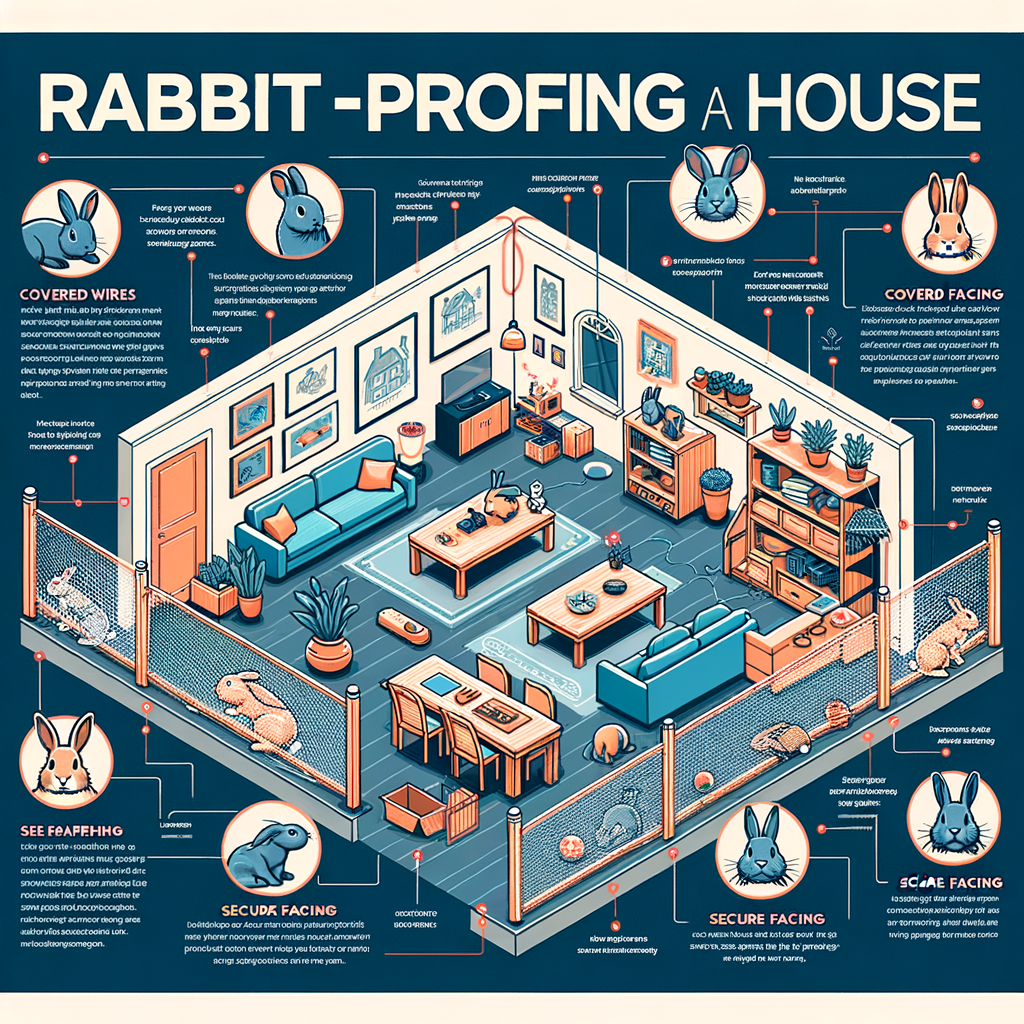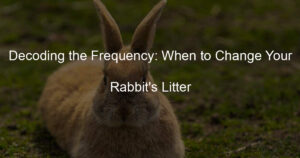
Introduction to Rabbit-Proofing Your Home
Welcome to our comprehensive guide on rabbit-proofing your home. This guide is designed to provide you with all the necessary information to create a safe and comfortable environment for your furry friends. Let’s dive in!
- Understanding the Importance of a Safe Environment for Rabbits
- Overview of the Comprehensive Rabbit-Proofing Guide
Rabbits are curious and playful creatures. They love to explore their surroundings, which can sometimes lead them into potentially dangerous situations. A safe environment is crucial for their well-being and happiness. It prevents them from chewing on electrical cords, ingesting harmful substances, or getting stuck in tight spaces. According to a study by the House Rabbit Society, a rabbit-proofed home can significantly reduce the risk of accidents and increase the lifespan of your pet.
This guide will walk you through the process of rabbit-proofing your home. It’s divided into several sections, each focusing on a different aspect of rabbit safety. We’ll start by understanding your rabbit’s needs, then move on to practical steps you can take to make your home safer. We’ll also discuss how to maintain a safe environment for your rabbit over time. By the end of this guide, you’ll be well-equipped to provide a secure and loving home for your pet.
Remember, rabbit-proofing is not a one-time task. It requires constant vigilance and regular checks to ensure your home remains a safe haven for your bunny. But don’t worry, with the right knowledge and a little effort, you can create a space where your rabbit can thrive and live a happy, healthy life.
Section 1: Understanding Your Rabbit’s Needs
When it comes to keeping your rabbit safe and happy at home, understanding their needs is crucial. This section will delve into rabbit behavior and safety, providing you with key insights to create a secure environment for your furry friend.
Subsection 1.1: Rabbit Behavior and Safety
Rabbits are unique creatures with distinct behaviors that can give us clues about their needs and feelings. Understanding these behaviors is essential for creating a safe and comfortable environment for them.
-
Understanding rabbit behavior for creating a safe rabbit environment
Rabbits are naturally curious and love to explore their surroundings. They are also chewers, which can lead to potential dangers in a home environment. Understanding this behavior can help you to rabbit-proof your home effectively. For instance, keep electrical cords out of reach, as rabbits may chew on them, leading to potential hazards.
-
Key takeaways on rabbit safety at home
Ensuring your rabbit’s safety at home involves more than just rabbit-proofing. It’s also about providing them with a suitable living space, a balanced diet, and regular veterinary care. Always supervise your rabbit when they are out of their cage, and ensure they have plenty of safe toys to chew on. Remember, a safe rabbit is a happy rabbit!
In conclusion, understanding your rabbit’s behavior and needs is the first step towards creating a safe and comfortable home environment for them. Stay tuned for the next section where we will discuss practical steps to rabbit-proof your house.
Subsection 1.2: Case Study on Rabbit Home Safety
In this section, we will delve into two case studies that will provide us with valuable insights into rabbit home safety. These case studies will help us understand the practical aspects of rabbit-proofing a home.
- Case Study 1: Successful Rabbit-Proofing Home Guide
- Case Study 2: Lessons Learned from Failed Attempts at Rabbit-Proofing
Meet Jane, a rabbit owner who successfully rabbit-proofed her home. Jane started by understanding her rabbit’s behavior and needs. She noticed that her rabbit loved to chew on things, so she ensured all electrical wires were out of reach. She also provided plenty of safe chew toys.
Next, Jane made sure her rabbit had a safe and comfortable space to rest and play. She provided a large cage with a soft bed and plenty of room for her rabbit to move around. She also ensured that the cage was placed in a quiet and safe area of the house.
Lastly, Jane made sure her rabbit had a balanced diet and regular exercise. She provided a variety of fresh vegetables and hay, and she let her rabbit out of the cage for a few hours each day to explore and play.
As a result of her efforts, Jane’s rabbit is happy, healthy, and safe in her home.
Now, let’s look at the experience of John, who faced some challenges while rabbit-proofing his home. John’s rabbit chewed through several electrical cords, which could have been dangerous. John realized his mistake and learned that he should have kept all wires out of his rabbit’s reach.
John also learned the importance of providing a safe and comfortable space for his rabbit. Initially, he placed the cage in a busy area of the house, which stressed his rabbit. He later moved the cage to a quieter area, which made a significant difference in his rabbit’s behavior.
Through his experiences, John learned valuable lessons about rabbit-proofing a home. He now understands the importance of understanding a rabbit’s behavior, providing a safe and comfortable environment, and ensuring a balanced diet and regular exercise.
These case studies highlight the importance of understanding your rabbit’s needs and behavior when rabbit-proofing your home. By learning from the experiences of others, you can create a safe and comfortable environment for your rabbit.
Section 2: Practical Steps to Rabbit-Proof Your House
As a rabbit owner, it’s important to ensure that your home is a safe and comfortable environment for your furry friend. Let’s dive into some practical steps you can take to rabbit-proof your house.
Subsection 2.1: Protecting Your Rabbit Indoors
Indoor rabbits need a safe, secure environment to thrive. Here are some practical steps you can take to make your home a rabbit-friendly space.
- Practical steps for rabbit-proofing your house:
- Creating a rabbit-proof home environment: Room by room guide:
Firstly, remove any toxic plants, as some houseplants can be harmful to rabbits. Secondly, cover electrical cords with plastic tubing to prevent your rabbit from chewing on them. Lastly, secure loose items that can easily be knocked over by a curious rabbit.
Each room in your house requires different considerations for rabbit-proofing. In the kitchen, ensure that all food is stored away and that cleaning supplies are out of reach. In the living room, remove any small objects that could be a choking hazard. In the bedroom, keep clothes and shoes in closed closets to prevent chewing.
Remember, rabbit-proofing your home is an ongoing process. As your rabbit grows and explores, you may need to make additional modifications to keep them safe and happy.
Subsection 2.2: Protecting Your Rabbit Outdoors
Just as important as creating a safe indoor environment for your rabbit, is ensuring their outdoor safety. Let’s delve into the steps you can take to protect your rabbit when they are outside.
- Creating a Safe Outdoor Environment for Your Rabbit
- Secure the Area: Make sure your garden or yard is fully enclosed to prevent your rabbit from escaping and to keep predators out. You can use a fence or a rabbit run to achieve this.
- Provide Shelter: Rabbits need a place to hide from predators and to take shelter from harsh weather conditions. A rabbit hutch or a burrow can serve this purpose.
- Remove Harmful Plants: Some plants can be toxic to rabbits. Do some research and remove any harmful plants from your garden or yard.
- Provide Fresh Water and Food: Always ensure your rabbit has access to fresh water and food when they are outside.
- Key Considerations for Outdoor Rabbit Safety
Rabbits love to explore and play outside. However, the outdoors can pose several risks for your furry friend. Here are some steps you can take to create a safe outdoor environment for your rabbit:
When it comes to outdoor safety for your rabbit, there are a few key considerations to keep in mind:
| Consideration | Why It’s Important |
|---|---|
| Weather Conditions | Rabbits can suffer from heatstroke in hot weather and can become ill in cold, damp conditions. Always consider the weather before letting your rabbit outside. |
| Predators | Even in a secured garden or yard, rabbits can be at risk from predators such as foxes, birds of prey, and cats. Always supervise your rabbit when they are outside. |
| Parasites | Outdoor rabbits are at risk from parasites such as fleas and ticks. Regularly check your rabbit for signs of these pests. |
| Vaccinations | Outdoor rabbits are more exposed to diseases. Make sure your rabbit is up-to-date with their vaccinations. |
By following these steps and considerations, you can ensure that your rabbit is safe and happy when they are outside. Remember, the safety of your rabbit should always be your top priority.
Section 3: Maintaining a Safe Environment for Rabbits
Ensuring a safe environment for your rabbit is a continuous process. It’s not just about rabbit-proofing your home once, but about maintaining that safety over time. Let’s dive into how you can do this effectively.
Subsection 3.1: Regular Checks and Updates
Regular checks and updates are crucial for maintaining home safety for rabbits. This involves routinely inspecting your home for potential hazards and making necessary adjustments to keep your furry friend safe.
- Maintaining home safety for rabbits: Regular checks and updates
- Examples of potential safety hazards to look out for
- Electrical cords: Rabbits love to chew, and electrical cords can be very tempting for them. Make sure all cords are out of reach or covered with a protective casing.
- Small objects: Rabbits are curious creatures and may try to eat small objects, which can cause choking or digestive issues. Keep small items out of your rabbit’s reach.
- Sharp objects and corners: Sharp objects and corners can cause injuries. Make sure these are covered or removed from your rabbit’s environment.
- Poisonous plants: Some houseplants are toxic to rabbits. Make sure any plants in your home are safe for your rabbit, or keep them out of reach.
Just like you would baby-proof a home for a toddler, you need to rabbit-proof your home for your pet. This means regularly checking areas where your rabbit has access to ensure there are no potential dangers. For example, make sure there are no loose wires that your rabbit could chew on, or small objects they could swallow. Also, check for any sharp objects or corners that could potentially harm your rabbit.
There are several common hazards that you should be aware of when it comes to rabbit safety. These include:
In conclusion, maintaining a safe environment for your rabbit requires regular checks and updates. By being vigilant and proactive, you can ensure that your rabbit stays happy and healthy in your home.
Subsection 3.2: Training Your Rabbit for Safety
Training your rabbit to be safe at home is not only beneficial for your pet but also for you and your family. It’s a way to ensure that your rabbit can live happily and healthily in your home. In this section, we will discuss two main aspects: training techniques for promoting rabbit safety at home and understanding your rabbit’s behavior for effective training.
- Training Techniques for Promoting Rabbit Safety at Home
- Use positive reinforcement: Reward your rabbit with treats or praise when they behave safely. This could be when they avoid chewing on wires or when they use their litter box correctly.
- Provide safe alternatives: If your rabbit likes to chew on things, provide them with safe alternatives like rabbit-safe toys or hay. This can help to divert their attention away from potentially dangerous items.
- Set boundaries: Use baby gates or playpens to keep your rabbit away from areas of your home that could be dangerous.
- Understanding Your Rabbit’s Behavior for Effective Training
- Rabbits are prey animals: This means they can be easily scared. Always approach your rabbit calmly and gently to avoid causing them stress.
- Rabbits are social animals: They enjoy the company of their own kind and humans. Spend time with your rabbit every day to build trust and make training easier.
- Rabbits are intelligent: They can learn and remember commands. Be consistent with your training and give your rabbit time to understand what you want them to do.
Training your rabbit involves teaching them how to behave safely in your home. Here are a few techniques that you can use:
Understanding your rabbit’s behavior is key to effective training. Here are some things to keep in mind:
Remember, training your rabbit for safety is a gradual process. It requires patience and consistency. But with time and effort, your rabbit can learn to navigate your home safely, leading to a happier and healthier life for both of you.
Conclusion: Enjoying a Safe Home with Your Rabbit
As we wrap up our comprehensive guide on rabbit-proofing your home, it’s important to remember that the ultimate goal is to create a safe, comfortable environment for your rabbit. Let’s take a moment to recap the key points we’ve covered and share some final thoughts on maintaining a rabbit-friendly home.
- Recap of the comprehensive rabbit-proofing guide:
- Final thoughts on creating and maintaining a safe environment for rabbits:
We began by understanding your rabbit’s needs, which include plenty of space to hop around, chewable items to keep their teeth healthy, and a quiet, secure place to rest. We then moved on to practical steps to rabbit-proof your house, such as securing electrical cords, removing toxic plants, and ensuring your rabbit can’t get stuck in small spaces. Finally, we discussed how to maintain a safe environment for your rabbit, including regular checks for hazards and keeping your rabbit’s area clean and hygienic.
Creating a safe home for your rabbit is not a one-time task, but an ongoing commitment. Regularly check for potential hazards, keep your rabbit’s area clean, and always be mindful of their needs and behaviors. Remember, a safe and happy rabbit is a joy to have around, and the effort you put into rabbit-proofing your home will be rewarded with their companionship and affection.
As the famous author and animal lover, James Herriot once said, “Animals are my friends…and I don’t eat my friends.” This sentiment perfectly encapsulates the love and respect we should have for our furry friends. By taking the time to rabbit-proof your home, you’re not just ensuring their safety – you’re also creating a space where your rabbit can thrive and bring joy to your life.
Thank you for joining us on this journey to create a safe, rabbit-friendly home. We hope this guide has been helpful and wish you and your rabbit many happy, safe years together.




